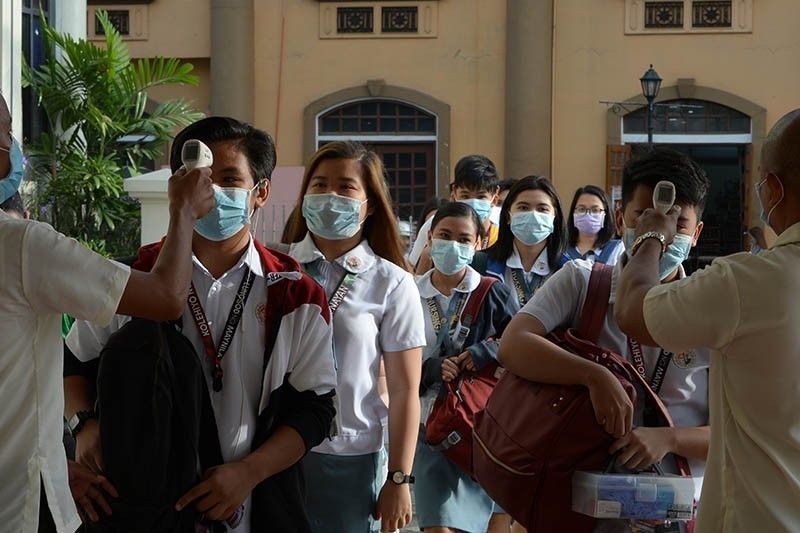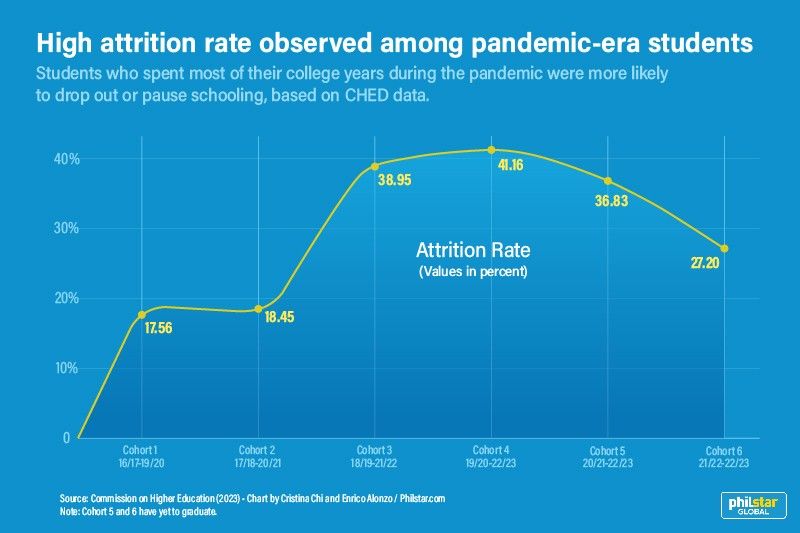Pandemic doubled attrition rate of college students — CHED data

MANILA, Philippines — Pandemic-era students were more likely to drop out or temporarily leave college, according to new data from the Commission on Higher Education, with the attrition rate of the most recent graduating batch doubling compared to pre-pandemic students.
CHED data shared during House budget deliberations on Wednesday show at least 41.16% of students who were sophomores when the pandemic first hit during SY 2020-2021 — and were supposed to graduate this year — paused or stopped their schooling.
This is more than double the attrition rate of college students who graduated early 2020 (17.56%), or the last batch of students who were not forced to experience full school years during the pandemic, according to CHED data.
CHED defines the attrition rate as the percentage of students who either temporarily leave college or drop out permanently. It is computed by measuring the percent change in enrollment between the first and last years of schooling of a batch of students.

Meanwhile, the cohort of students who graduated in SY 2020-2021 had a modest uptick in attrition at 18.45%.
But the attrition rate skyrocketed the next year, going up to 38.95% for the graduating batch of SY 2021-2022.
And in 2023, the most recent graduating batch recorded the highest attrition rate at 41.16%.
Philstar.com has requested data on the attrition rates of earlier years. We will update this story with CHED’s response.
Pandemic survival
A more extreme case of attrition happened in one cohort of architecture students at a private university in Laguna.
In an interview with Philstar.com, architecture graduate Leejay Corea said that of the 34 students part of his batch in his first year, he was the only one to graduate and walk the stage in May.
Students every year seemingly got picked off one by one until only five students made it to their penultimate year in school, Corea recounted.
Most of his classmates did their best but did not have enough money to purchase materials for their plates or had other responsibilities at home, Corea said.
“We were down to just five during the fourth year of the second semester. Completing and passing online tasks became extremely difficult. Some had issues with internet connectivity, while others faced financial and mental problems,” he said in Filipino.
Corea entered his fifth year alone. Many of his professors sympathized with his situation, but they were firm in upholding what Corea described as “high standards.”
“I felt lost, unsure of what to do. It reached a point where I wanted to take a break for a year and join the fourth-year students, as it was tough not having someone to ask for guidance,” he said.
Corea is the first in his family to graduate college. He credits his success to his older siblings, who helped him financially, and his father, who pushed him to pick up his unfulfilled dream of pursuing architecture.
CHED Chairperson Prospero De Vera told a House panel in May during an oversight hearing that recent graduation rates did not match the rate at which students were dropping out of college.
"The not-so-good news is that if you look at graduation rates, (it has not) increased as significantly as the enrollment rates," De Vera said.
"The dropout rate I think is more significant in private universities than public universities because of the cost of education," the CHED chair added.
Attrition rate still high for present cohorts of students
CHED also provided data for the cohorts of students who have yet to complete four years of schooling.
For college students who entered SY 2020-2021 — meaning they were first-year students when the pandemic happened — have seen at least 36.83% dropping out or temporarily leaving school.
Meanwhile, the cohort of students who entered college the following year during SY 2021-2022 recorded a lower attrition rate at 27.20% — still higher than the cohort who graduated in SY 2019-2020.
Colleges and universities officially began returning to full face-to-face classes in early 2023, making the Philippines one of the last countries to reopen campuses in higher and basic education during the COVID-19 pandemic.
While several studies have underscored the impact of the pandemic on younger students, there is also evidence pointing to the health crisis' impact on tertiary education students.
Lack of adequate infrastructure, mental health difficulties and the hefty costs of online classes have forced several students to pause or stop their education.
College-aged Filipinos particularly struggle with depression and suicidal thoughts. A 2021 study by the University of the Philippines' Population Institute estimated that around one in five Filipinos aged 15 to 24 years old — or 1.5 million in total — have considered ending their own life. Most or six in 10 did not reach out to anyone about their suicide ideation.
RELATED: House resolution for nationwide study on students' mental health filed
Corea said that he still feels sad about having to graduate alone, knowing that "around 70%" of his batchmates did not leave the program or the school of their own choice.
The now-architecture apprentice said that he has committed to helping his batchmates eventually graduate, starting with lending out his notes and helping them with their plates.
“I felt guilty because I kept asking myself – why were they failing or dropping out? Why was this happening when I knew that we were submitting nearly the same quality of outputs,” Corea said.
“I was lucky because I had enough support to overcome the challenges that came my way. But what about them?”
- Latest
- Trending































